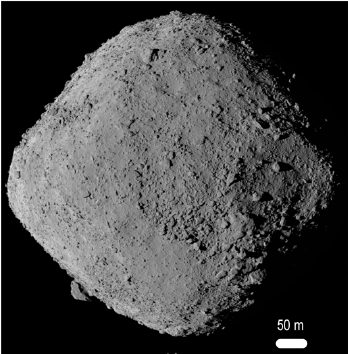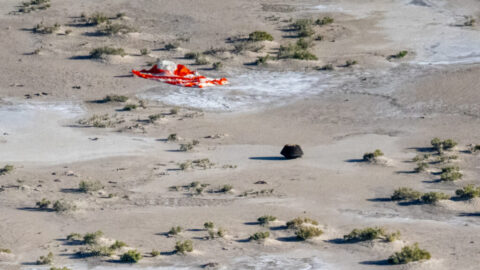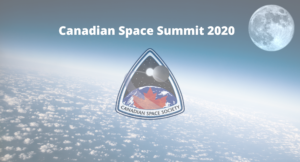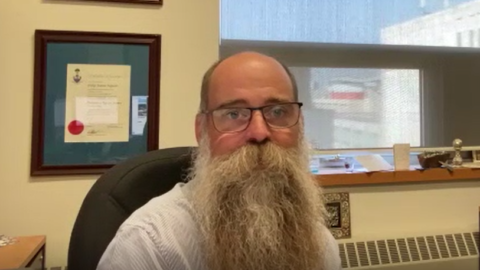We met up with Tim Haltigen, Planetary Senior Mission Scientist at the Canadian Space Agency for a Question and Answer about the Bennu Asteroid sample return mission OSIRUS-Rex that is due to return its precious cargo to earth September 24, 2023 at 8am. Interview between Timothy Haltigen and Joshua Sorell
Q: Okay, Timothy, can you tell us a little bit about the Osiris Rex mission, when it was launched, and what the objective is?
A: Yeah, for sure. So first off, just Tim is fine. The Osiris Rex mission is an incredible adventure. Really think about it. It’s a mission that takes us to the very beginnings of the solar system. So this is a mission that’s led by NASA, that had significant Canadian technical and scientific contributions that launched under a perfectly cloudless sky on September 8th, 2016. this is a mission to retrieve a sample of an asteroid called Bennu and bring it back to earth so that we can study a lot more to understand what it’s made of and really what it can tell us about the early, early solar system. The great thing about asteroids is that these are materials that are largely unchanged from the beginnings of the solar system and so by understanding what asteroids are made of, really what it’s telling us about is, is the chemistry of the early solar system and how planetary bodies formed in the first place. So it’s incredibly exciting for us to understand what was going on at the beginning of the solar system and really look into things like the origin of life and organic compounds and potentially look at how water may have been delivered to the early earth as well. So lots of fun mysteries to unravel.
Q: That’s a good information. Okay, so why was Bennu specifically chosen for a sample return mission?
A: So Benny is a really neat asteroid and it ended up being selected for a number of reasons. Now to start off there’s over half a million asteroids that we know about and so it’s a natural question. How did we get to Benny? So. In terms of the half million or so that we know of only a handful of those, just over 7, 000 are considered near earth asteroids. So these are the family of asteroids that we could feasibly get a spacecraft to in a reasonable amount of time. Now, of those, less than 200 have orbits that would allow us to get a spacecraft to the asteroid and also bring it back to Earth, which is obviously crucial for a sample return. So that’s under 200 we had to choose from. Of those 200, there are only about 25 or 26 that had a size that was greater than 200 meters and the reason that’s important is that if asteroids are too small, they actually spin really, really quickly. The faster they spin, the more difficult and more risky it would be to try to place a spacecraft at the surface. We needed something with a minimum size of about 200 meters. So that left us, like I said, with about 25 or 26. Now, of those, only 5, uh, were made of the materials that we were the most interested in that were, full of carbon. Of those 5, Bennu was ultimately selected because this is one that that does come very, very close to Earth and understanding its orbit in great detail would actually allow us to then better predict where this asteroid is going to be in the future as well. So it was a number of steps to get us all the way down from half a million down to a venue that we eventually selected.
Q: Why did you want a carbon composition in the asteroid.
A: Carbon is a really, really neat element. One of the critical things here is that carbon is you know, the foundation of organic molecules. One of the big questions we have about asteroids are whether or not it was early forming asteroids that delivered these organic molecules to earth. So we’re not talking about. Life itself here, but we’re talking about compounds like amino acids, for example, and so amino acids are the building blocks you can think. So think of them almost as the Lego pieces were delivered to Earth early on. Bringing back samples of this organic material from the very beginning of the solar system allows us to understand. Are they the same as they are now? Are they different? and if they’re different, why are they different? So that was a really crucial piece and a big science question. We’re trying to answer.
Q:Could you talk about the why Benny was shaped like it is like a diamond and specifically if it relates to the York effect?
A: it’s interesting and it’s still a subject of a little bit of debate as to why, um, why the asteroid is, is shaped more like more like a diamond more then than a perfect sphere. There’s been a lot of debate about this over the last number of years. It used to be believed that these materials or that these asteroids were formed more as spheres and as they spun up and as they aged eventually, more and more material would be moved towards the equator. That’s why you would get that bulge. But one of the interesting things about these, these rubble pile asteroids that, that are diamond shaped is that they’re very loosely consolidated. You can think of them almost more as you know, bits of grains that are just loosely held together as opposed to a giant piece of solid rock. And so there’s been some simulations done that actually suggest, that these were formed as diamonds early on because of the physics, the way that the forces work in space when you have loosely Held material together, there’s a force that’s weaker at the equator than at the pole that actually allows more material to accumulate there and so the more current hypothesis is that these were formed as diamonds. In fact, very early on in their formation and haven’t changed an awful lot since. O
Q: How many grams of sample does Canada get for the sample return?
A: In exchange for the contribution of the Canadian instrument, OLA (OSIRUS-REx laser altimeter), and all of the support for the Canadian scientists on the mission, we’re very, very fortunate that Canada is going to be getting 4% Of the material that’s returned. While we don’t know exactly how much material was captured, and we won’t know until we open up the canister in September, the estimates right now range somewhere between 150 grams and 350 grams total. So that would translate into somewhere between 6 and 14 grams coming back to Canada. And what’s amazing about this is that this is going to be the largest amount of mass that has been returned from any sample return mission since the Apollo days. And in fact, is going to be the largest sample mass returned from anywhere outside of the lunar orbit. So there’s an awful lot of material here that’s going to pave the way for generations of science to take place.
Q: How is that sample going to be returned to earth? Do they put it in a capsule and launch it to Earth or how does it come back?
A: Yeah, so the entire spacecraft actually is on its way back to Earth right now. It departed asteroid Bennu in, in 2021 and it’s taken just over two years to get back to Earth. The entire spacecraft is coming back and on September the 24th will be releasing the Earth entry capsule. The sample canister has been securely placed within this earth return capsule. The capsule will be released from the spacecraft and will be landing hopefully very gently in the Utah desert on September the 24th, around 8 am.
Q: If it lands non gently, do you still get to keep the sample?
A: There are a number of contingencies in place for an off nominal landing the plan. The engineering has been spectacular to date so far. We’re fully expecting success, but there are some contingencies in place to ensure that a sample recovery can still take place. And we’d be working with our international partners to understand how best to allocate what sample is there .
Q: Tell us about the Canadian provided OSIRIS-REx laser altimeter (OLA)
A: Yes, OLA. It is an amazing, amazing instrument. This is an instrument that was designed and built by MDA, with large contributions from Optech, and the science leadership came from York University. And it was, it’s a spectacular piece of equipment that allowed us to very precisely measure the shape of the asteroid and so the reason that you want to understand the shape really well at high resolution, and for two reasons, one is that it helps you interpret the geology that you’re seeing. With some of the other tools that we had on board, we were able to understand at sort of a bulk level, what the composition of the asteroid is. And in geology, it’s always important to relate material and shape because that really helps tell you the story about the formation in the history of the asteroid. So really, step one was, we need to understand the shape to better understand the geological history of the asteroid. Now, the second one was a lot more practical, which was we had to understand where on the asteroid was safe to place the spacecraft in contact with it to collect a sample. We ended up spending close to 2 years studying the asteroid in great detail and using two of the lasers on board, on Ola, we were able to fire and take close to 3 billion measurements, individual measurements, and put together what is now the most detailed 3 dimensional model of any body in the history of space exploration. It’s just incredible. You can imagine this is an asteroid. That’s roughly the size of the CN tower. It’s about 500 meters in diameter and we understand the shape of this entire body at a one point every five to seven centimeters or so, it’s just incredible wild.

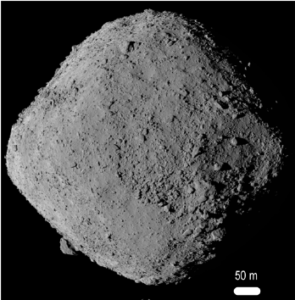
Bennu on the left is a radar image captured from earth (Credit: Michael C. Nola / Arecibo Observatory), on the right is an image from the OSIRIS-REx (Credit: NASA/Goddard/University of Arizona)
Q: Do you have a 3d printed a model of Bennu?
A: We in fact, yeah we do. It’s funny to think of. What we used to think the asteroid was shaped like, and what it is now, all of the original estimates of of Bennu’s shape were based on radar models using radar, radars on Earth in fact, and so we understood that it would have this sort of spinning top shape. Once we got there, it was just fascinating to see the diversity of all the boulders and all of the features and craters and everything that we saw. We’ve actually made a before and after 3D print of the asteroid.
Q: You ended up choosing Nightingale as the landing site, right? Tell us about the features of the landing site and why it was beneficial.
A: The way that the team had intended to select a sampling site at the beginning was really based on 4 criteria. (1) was called safety, which is: is this an area that’s free of of large hazardous boulders that that could damage the spacecraft. We had to assess the entire asteroid for safety. (2) something called sample ability, which is: is there enough small material or small granular material at that location that we could potentially collect? Because the way that the sampling device was. was designed is that the maximum size of particle that it could take in was about two centimeters or so. We had to make sure that there was enough small material at that location that the sampling device would be able to, to ingest some of it. (3) there was something called deliverability, which is: is this a location on the asteroid that we can actually navigate the spacecraft to. And then finally, (4) something called science value, which is: is this a region that looks like it’s going to have enough diverse material that will be very interesting to help us answer all of our science questions. We started off with, I think it was about 32 sites that were under consideration and slowly did a down select based on those 4 criteria. And we ended up with Nightingale because it was, it satisfied the best of those 4. Now, that being said, it was a very, very challenging exercise because all of the mission requirements had been outcomes. Assuming that the asteroid would be a relatively benign environment, maybe a few boulders here and there, but largely sort of small particles all over the place, almost like we would be able to land on a beach. And when we got there, and we took our 1st images, everyone was just shocked to see that the surface was covered in thousands and thousands and thousands of boulders. We had to completely redesign how we were going to take the sample, the target size that we were going to aim at and how we were going to navigate around this very, very rough surface to make sure that we could find a site that was safe. Thanks to the scientists and the engineers on the team we managed to select a site that that we felt we could sample and successfully collected the sample on the 1st attempt.
Q: How did you collect the sample? Or what was the sampling method?
A: On the spacecraft, there was a deployable arm that was about three meters in length or about 10 feet. Think about an arm sort of the size or the height of a basketball net. It was deployed after the site was selected and the spacecraft slowly descended towards the asteroid. It was a really neat method actually, the cameras on board the spacecraft all were all used almost like the eyes of the spacecraft. It compared where it was at any given point to a map that we had put into its memory of where it should be and making that constant calculation. It was able to adjust itself to make sure that it was pointed directly at the sampling site. It descended very, very slowly and made contact with the surface and at the end of the arm was a circular piece that looks almost like the air filter in your car. And what happened is when it made contact, it released pressurized nitrogen gas that made a big plume of dust and small particles. Some of those particles were then ingested into this air filter like device, which was called The Touch and Go Sampling Mechanism, or TAGSAM, as it’s known. Some of this material was ingested into the TAGSAM. The spacecraft then fired its propulsion system to back away immediately from the surface of the asteroid out to a safe distance, which is where we assessed that we had successfully collected sample. That’s awesome, the whole thing, it’s incredible to think that, you know, this is a mission that a spacecraft that had flown 2 billion kilometers to catch up to this asteroid, over the course of 2 years, and we studied it for 2 years. And it all came down to under 30 seconds of contact with the surface. it was really, really quite an exciting day when we realized that we’d successfully collected samples.
Q: That’s awesome. So that’s most of my questions, to close the meeting off is there anything else that you’d like to add about the sample return mission.
A: there’s a couple of things: 1 is I think it’s a great example that highlights Canadian technical and scientific expertise on the international stage, data from Ola were crucial in terms of selecting that sampling site and so we’re just really proud of the science team, and the industry team that put the instrument together and worked on it. The second thing that that’s really exciting about sample return missions in general is you can think of them almost as the gift that keeps on giving, when you think about the Apollo samples, for example, the last Apollo mission was over 50 years ago, and we’re still making brand new discoveries on those materials today, because we have equipment that just didn’t exist 50 years ago, and we have the maturity to ask Scientific questions that we didn’t know how to ask 50 years ago and so, for me, that’s 1 of the really exciting parts of this mission is that it’s not just about what’s the science we’re going to be doing this fall. When the samples returned or next year, this is about what’s the science we’re going to be doing in 2033, 2073, and being able to make these samples available to Canadians and to international scientists for decades to come means that really the mission gets to keep living for, you know, for another 50 years for several generations. I’m just really, really proud that we were able to do that.
Q: Thank you for the great information and for the wonderful interview.
A: No, thanks for taking the time and thanks for the invitation. It is a really exciting mission. And it’s just amazing to think that September, the 24th, 2023 was always this date that was off in the future. And to think that we’re now just a few months away is unbelievable.
Read more about the OSIRIS-REx mission at the NASA website HERE

